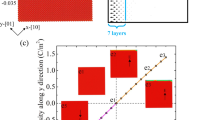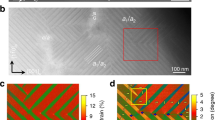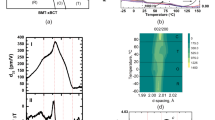Abstract
Ferroelectric ceramics are widely used as sensors and actuators for their electro-mechanical properties, and in electronic applications for their dielectric properties. Domain switching – the phenomenon wherein the ferroelectric material changes from one spontaneously polarized state to another under electrical or mechanical loads – is an important attribute of these materials. However, this is a complex collective process in commercially used polycrystalline ceramics that are agglomerations of a very large number of variously oriented grains. As the domains in one grain attempt to switch, they are constrained by the differently oriented neighbouring grains. Here we use a combined theoretical and experimental approach to establish a relation between crystallographic symmetry and the ability of a ferroelectric polycrystalline ceramic to switch. In particular, we show that equiaxed polycrystals of materials that are either tetragonal or rhombohedral cannot switch; yet polycrystals of materials where these two symmetries co-exist can in fact switch.
This is a preview of subscription content, access via your institution
Access options
Subscribe to this journal
Receive 12 print issues and online access
$259.00 per year
only $21.58 per issue
Buy this article
- Purchase on Springer Link
- Instant access to full article PDF
Prices may be subject to local taxes which are calculated during checkout



Similar content being viewed by others
References
Damjanovic, D. Ferroelectric, dielectric and piezoelectric properties of ferroelectric thin films and ceramics. Rep. Prog. Phys. 61, 1267-1324 (1998).
Cross, L. E. in Ferroelectric Ceramics (eds Setter, N. & Colla, E. L.) 1-85 (Birkhauser, Berlin, 1993).
Xu, Y. Ferroelectric Materials and Their Applications (North-Holland Elsevier Science, Amsterdam, 1991).
Jaffe, B., Cook, W. R. & Jaffe, H. Piezoelectric Ceramics (Academic, London, 1971).
Bhattacharya, K. & Ravichandran, G. Ferroelectric perovskites for electromechanical actuation. Acta Mater. 51, 5941-5960 (2003).
Cohen, R. E. Origin of ferroelectricity in perovskite oxides. Nature 358, 136-138 (1992).
King-Smith, R. D. & Vanderbilt, D. Theory of polarization of crystalline solids. Phys. Rev. B 47, 1651-1654 (1993).
Resta, R. Ab initio simulation of properties of ferroelectric materials. Mol. Simul. Mater. 11, R69-R96 (2003).
Waghmare, U. V. & Rabe, K. M. Ab initio statistical mechanics of the ferroelectric phase transition in PbTiO3 . Phys. Rev. B 55, 6161-6173 (1997).
Meyer, B. & Vanderbilt, D. Ab initio study of ferroelectric domain walls in PbTiO3 . Phys. Rev. B 65, 104111 (2002).
Stemmer, S., Streiffer, F. & Ruhle, M. Atomistic structure of 90 degree domain walls in ferroelectric PbTiO3 thin films. Phil. Mag. A 71, 713-724 (1995).
Shilo, D., Ravichandran, G. & Bhattacharya, K. Investigation of twin-wall structure at the nanometre scale using atomic force microscopy. Nature Mater. 3, 453-457 (2004).
Hu, H. L. & Chen, L. Q. Three-dimensional computer simulation of ferroelectric domain formation. J. Am. Ceram. Soc. 81, 492-500 (1998).
Ahluwalia, R. & Cao, W. W. Influence of dipolar defects on switching behavior in ferroelectrics. Phys. Rev. B 63, 012103 (2001).
Zhang, W. & Bhattacharya, K. A computation model of ferroelectric domains. Part I. Model formulation and domain switching and Part II. Grain boundaries and defect pinning. Acta Mater. 53, 185-209 (2005).
Noheda, D. E. et al. A monoclinic ferroelectric phase in Pb(Zr1−xTix)O3 . Appl. Phys. Lett. 74, 2059-2061 (1999).
Berlincourt, D. A. & Krueger, H. A. Domain processes in lead titanate zirconate and barium titanate ceramics. J. Appl. Phys. 30, 1804-1810 (1959).
Jaffe, B., Roth, R. S. & Marzullo, S. Piezoelectric properties of lead zirconate-lead titanate solid-solution ceramics. J. Appl. Phys. 25, 809-810 (1953).
Berlincourt, D. A., Cmolik, C. & Jaffee, H. Piezoelectric properties of polycrystalline lead titanate zirconate compositions. Proc. Inst. Radio Eng. 48, 220-229 (1960).
Isupov, V. A. Properties of Pb(Ti,Zr)O3 piezoelectric cermaics and nature of their orientational dielectric polarization. Sov. Phys. Solid State 10, 989-991 (1968).
Taylor, G. I. Plastic strain in metals. J. Inst. Metals 62, 307-324 (1938).
Bhattacharya, K. & Kohn, R. V. Texture, symmetry and reoverable strains of shape-memory polycrystals. Acta Mater. 44, 529-542 (1996).
Tickle, R., James, R. D., Shield, T., Wittig, M. & Kokorin, V. V. Ferromagnetic shape memory in the NiMnGa system. IEEE Trans. Magn. 35, 4301-4310 (1999).
Shu, Y. C. & Bhattacharya, K. Domain patterns and macroscopic properties of ferroelectric materials. Phil. Mag. B 81, 2021-2054 (2001).
DeSimone, A. & James, R. D. A constrained theory of magnetoelasticity. J. Mech. Phys. Solids 50, 283-320 (2002).
Ball, J. M. & James, R. D. Fine phase mixture as minimizers of energy. Arch. Ration. Mech. Anal. 100, 13-52 (1987).
Li, J. Y. & Liu, D. On ferroelectric crystals with engineered domain configurations. J. Mech. Phys. Solids 52, 1719-1742 (2004).
Jona, F. & Shirane, G. Ferroelectric Crystals (Dover, New York, 1993).
Viehland, D. & Powers, J. Effect of uniaxial stress on the electromechanical properties of 0.7Pb(Mg1/2Nb2/3)O3-0.3PbTiO3 crystals and ceramics. J. Appl. Phys. 89, 1820-1825 (2001).
Park, S. E. & Shrout, T. R. Ultrahigh strain and piezoelectric behavior in relaxor based ferroelectric single crystals. J. Appl. Phys. 82, 1804-1811 (1997).
Rogan, R. C., Ustundag, E., Clausen, B. & Daymond, M. R. Texture and strain analysis of the ferroelastic behavior of Pb(Zr,Ti)O3 by in situ neutron diffraction. J. Appl. Phys. 93, 4104-4111 (2003).
Rogan, R. C. Investigation of the Multiscale Constitutive Behavior of Ferroelectric Materials Using Advanced Diffraction Techniques. Thesis, California Inst. Technology (2004).
Larson, A. C. & Von Dreele, R. B. GSAS: General Structure Analysis System. Report No. LAUR 86-748 (Los Alamos National Laboratory, 1986).
Acknowledgements
The authors thank M. Daymond, E. Oliver and J. Santisteban for their assistance with the experiments, a referee for suggesting the consistency check using the spontaneous polarization of PZT ceramics, and gratefully acknowledge the financial support of the US Army Research Office through DAAD 19-01-1-0517.
Author information
Authors and Affiliations
Corresponding author
Ethics declarations
Competing interests
The authors declare no competing financial interests.
Supplementary information
Supplementary Information
Supplementary information S1 (PDF 134 kb)
Rights and permissions
About this article
Cite this article
Li, J., Rogan, R., Üstündag, E. et al. Domain switching in polycrystalline ferroelectric ceramics. Nature Mater 4, 776–781 (2005). https://doi.org/10.1038/nmat1485
Received:
Revised:
Accepted:
Published:
Issue Date:
DOI: https://doi.org/10.1038/nmat1485
This article is cited by
-
Biferroelectricity of a homochiral organic molecule in both solid crystal and liquid crystal phases
Nature Communications (2022)
-
Near-ideal electromechanical coupling in textured piezoelectric ceramics
Nature Communications (2022)
-
Revealing intrinsic and extrinsic piezoelectric contributions in phase coexistence system of PbTiO3-BiScO3
Science China Materials (2022)
-
Enhanced energy storage performance and magnetocapacitance effect of polycrystalline BiFeO3 ceramics
Journal of the Australian Ceramic Society (2022)
-
Avalanche criticality during ferroelectric/ferroelastic switching
Nature Communications (2021)



